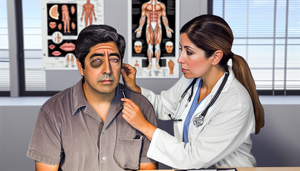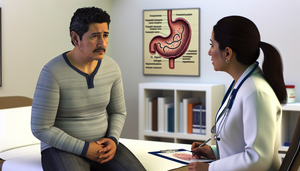
Plantar Fasciitis vs. Achilles Tendinitis: Diagnostic Guidelines for Heel Pain and Effective Stretching Exercises
Discover how to differentiate between plantar fasciitis and Achilles tendinitis for effective heel pain management.
Read more
Polymyalgia Rheumatica vs. Giant Cell Arteritis: Timely Management of Elderly Patients with Shoulder Pain and Elevated ESR to Reduce Risk of Blindness
Discover how early diagnosis and proper management of PMR and GCA can prevent serious complications.
Read more
Ankylosing Spondylitis vs. Mechanical Low Back Pain: Recognizing Axial Inflammation and Lumbar Stiffness through the Schober Test
Discover how to differentiate between ankylosing spondylitis and axial inflammation for effective treatment.
Read more
Rotator Cuff Injury vs. Frozen Shoulder: Differentiating Pain Causes and Enhancing Mobility with Shoulder Ultrasound and Rehabilitation
Discover how to differentiate between rotator cuff injury and frozen shoulder for effective treatment.
Read more
Fibromyalgia vs. Chronic Fatigue Syndrome: A Comprehensive Assessment of Musculoskeletal Pain and Persistent Fatigue
Discover how to differentiate and comprehensively evaluate fibromyalgia and chronic fatigue syndrome.
Read more
Rheumatoid Arthritis vs. Osteoarthritis: Key Steps for Differential Diagnosis of Inflamed Joints and Morning Stiffness
Discover how accurate differential diagnosis between rheumatoid arthritis and osteoarthritis enhances treatment outcomes.
Read more
Dementia vs. Delirium: Guidelines for Differentiating Cognitive Impairment and Attentional Fluctuations through Neuropsychological Evaluation
Discover how to differentiate between dementia and delirium to enhance patient treatment and outcomes.
Read more
Cluster Headache vs. Trigeminal Neuralgia: Key Clinical Insights for Managing Intense Facial Pain and Triggers
Discover the key clinical differences between cluster headaches and trigeminal neuralgia for effective management.
Read more
Acute Encephalitis vs. Meningitis: Early Identification of CNS Infection in Patients with Fever and Neck Stiffness
Early identification of encephalitis and meningitis is crucial for improving clinical outcomes and reducing complications.
Read more
Guillain-Barré Syndrome vs. CIDP: How to Differentiate Demyelinating Disorders in Ascending Weakness
Discover how to differentiate Guillain-Barré syndrome from chronic demyelinating polyneuropathy for effective treatment.
Read more
Epileptic Seizures vs. Syncope: Key Insights for Proper Diagnosis and Management
Discover how to differentiate between epileptic seizures and syncope for accurate and effective diagnosis.
Read more
Identifying the Origin of Tremors: Parkinson's Disease vs. Essential Tremor
Discover how to differentiate between Parkinson's disease and essential tremor for precise treatment.
Read more
Differentiating Multiple Sclerosis and ALS: Key Neurological Insights on Progressive Weakness, Electromyography, and MRI
Discover the keys to differentiate between multiple sclerosis and ALS through advanced diagnostics and biomarkers.
Read more
Bell's Palsy vs. Stroke: Essential Neurological Examination for Facial Weakness
Distinguishing between Bell's palsy and stroke is crucial for appropriate and timely treatment.
Read more
Stroke vs. TIA: Urgent Assessment to Prevent Neurological Deficits and Optimize Thrombolysis Timing
Urgent assessment of stroke and TIA is crucial to prevent permanent neurological deficits.
Read more
Migraine vs. Tension-Type Headache: A Practical Guide for Diagnosis in Clinical Practice
Discover how to effectively differentiate between migraine and tension-type headache for optimal treatment.
Read more
Acute vs. Autoimmune Hepatitis: Differentiating the Causes of Elevated Transaminases and Jaundice
Discover how to differentiate between acute and autoimmune hepatitis for precise and effective treatment.
Read more
Esophageal Cancer and Achalasia: Risk Factors and Endoscopic Findings in Dysphagia Evaluation
Explore how endoscopic surveillance in achalasia can prevent esophageal cancer.
Read more
Functional Dyspepsia vs. H. pylori Infection: When to Suspect Bacterial Infection and Consider Breath Test for Eradication Treatment
Discover when the eradication of H. pylori can relieve functional dyspepsia in your patients.
Read more
Acute Appendicitis vs. Ovarian Torsion: The Challenge of Diagnosing Right Iliac Fossa Pain with Abdominal Ultrasound and Inflammation Markers
Discover how to differentiate between acute appendicitis and ovarian torsion in cases of acute abdominal pain.
Read more